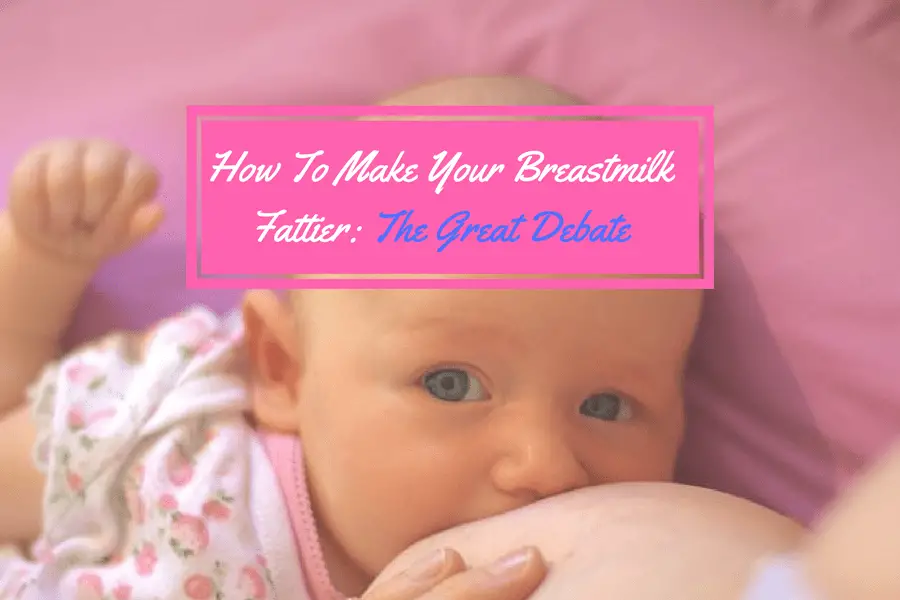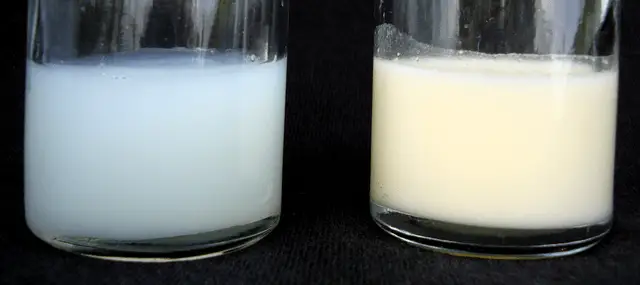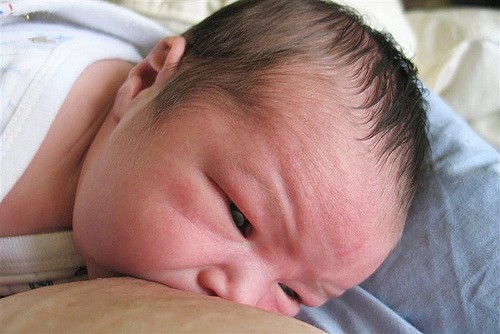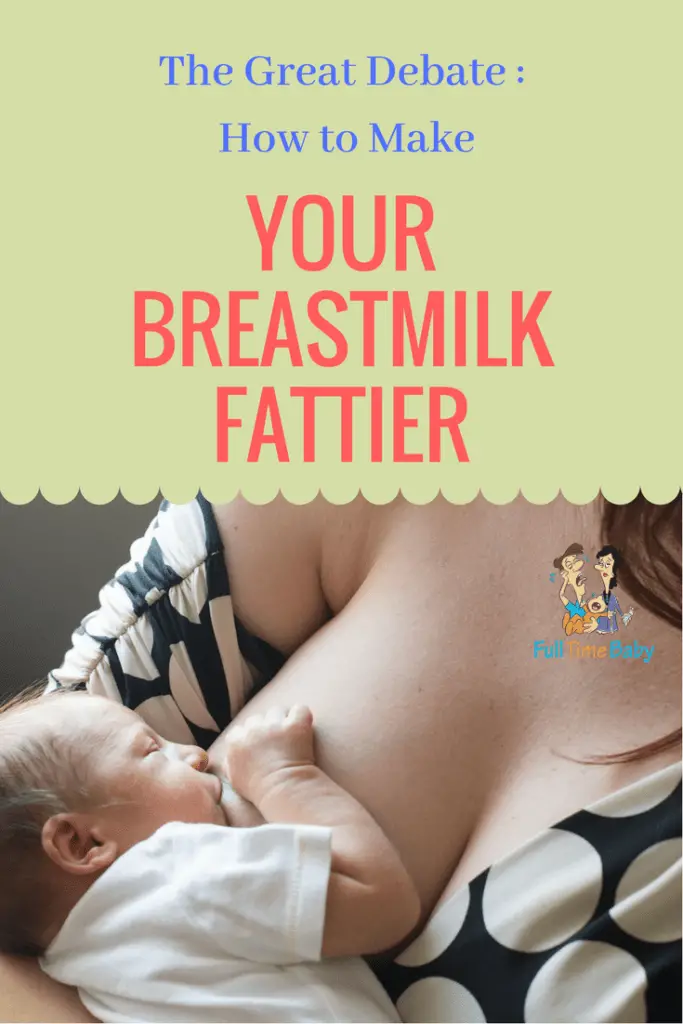One of the biggest concerns that new moms have is whether their babies are getting enough milk. Too make the confusion worse, now many mothers are being told that they need to worry about whether their milk has enough fat content. This has led to a lot of senseless advice about foremilk and hindmilk production.
Breastmilk Fat Content
Breastmilk contains everything your baby needs to grow and develop healthily. One of these components is fat, which is incredibly important for brain, eye, and nervous system development. Fat is also important for absorbing fat-soluble vitamins. (1)
According to one study, the fat content of human breastmilk is 41.1 grams per liter. However, this amount varies drastically. The range was 22.3 to 61.6 grams per liter. (2)
Foremilk vs. Hindmilk
Here is where mommy forums will put you in a panic. You may have heard about the difference between foremilk and hindmilk.
- Foremilk: This is the milk which comes out of the breast first. It has a higher lactose content, which is important for providing your developing baby’s body with energy. Lactose is also important for feeding gut bacteria and protecting against pathogens, as well as helping with the absorption of calcium. (3)
- Hindmilk: Fat tends to stick to the milk ducts in the breast. As the breast is emptied, this fat starts to come out into the milk. Thus, the milk that comes out further into a feeding (hindmilk) is higher in fat content. (4)
You can see the fat content of breastmilk yourself. Just pump some milk and let it sit in the bottle for a while. The fattier milk will rise to the top and the less-fatty milk will settle on the bottom.
There Is No “Good” and “Bad” Breastmilk
Because hindmilk contains more fat, a lot of moms interpret this as “foremilk is bad, and hindmilk is good.” They may then follow all sorts of bad advice (more on this bad advice below) to make sure their infant is getting more hindmilk.
While it is true that fat content increases as an infant feeds from a breast (5), there is no set moment when foremilk turns into hindmilk.
Foremilk and hindmilk are NOT two “types” of breastmilk. All breastmilk contains both foremilk and hindmilk! If you are stressing about what “type” of milk your baby is getting, you risk upsetting natural feeding patterns. (6)
Bad Advice for Increasing Breast Milk Fat Content
Just do a Google search for “increase breast milk fat content” and you’ll find all sorts of advice. The most common advice for increasing hindmilk includes:
- Taking supplements to increase healthy fats in the mother.
- Applying pressure to the breasts while feeding (supposedly to help “detach” the fatty milk stuck inside milk ducts).
- Massaging the breast (also to “detach” fat inside the breast).
- Pumping before feeding (to get rid of foremilk and reach hindmilk).
- Not switching breasts during a feeding (so the breast is emptied and the infant accesses hindmilk).
Of all of this advice, the last two are particularly worrisome for mothers. Again, while the advice might seem logical, it can backfire.
Pumping before Feeding
Breastfeeding is very time consuming and exhausting for mothers. I can’t imagine why a woman would want to make newborn care harder on herself by pumping milk before feeding!
If you pump before a feeding to “access the hindmilk,” you also risk some potential problems.
- The delay caused by pumping means your infant may be very hungry by the time you start feeding. Hungry, screaming infants swallow a lot of air (causing colic).
- Your breastmilk supply will naturally adjust to your infant’s needs. If you are pumping before a feeding, your body will start producing too much milk. This can result in a foremilk/hindmilk imbalance. (7)
Not Switching Sides during a Feeding
This is the most common advice that women get for increasing fat content of milk. Since milk becomes fattier as the infant drains a breast, it does seem to make sense that you shouldn’t let the infant switch sides until the breast is “empty.”
There are a few problems with this theory.
First off, a breast is never truly empty of milk. Production of new milk starts as your infant suckles. In the meantime, your baby is left sucking on the breast to get the fattier milk. It takes a lot more effort to get that fatty milk out (just like how a milk shake is harder to suck through a straw than milk). Your infant might fall asleep from the effort, meaning he isn’t getting enough to eat during the feeding.
Secondly, we know that there is something that triggers infants to release from the breast when they have had enough fatty milk. There is no set time when this occurs. It could be 10 minutes after feeding starts or 45 minutes. When your baby releases from one breast, offer the other!
As IBCLC lactation consultant Philippa Pearson-Glaze says, refusing to switch sides is the equivalent of denying your child a “three course meal” from the second breast.
“When a baby isn’t gaining weight, they most likely need more milk, not more time on an already empty breast which will further reduce a mother’s supply. An extra 7-8ml of high fat milk from the same breast is no substitute for the extra 70-80ml of fore-hind-and-in-the-middle-milk they might need from the other breast.”
Thirdly, if you are trying to keep your baby on one breast (even when he keeps releasing), you aren’t letting your other breast be drained properly. This can result in reduced milk production. (8)
What Actually Matters with Breastmilk Fat Content
Still worried that your baby needs more of fatty hindmilk? Remember, foremilk and hindmilk are NOT two separate types of milk. All milk contains foremilk and hindmilk. During some feedings, your breastmilk will contain more of one than the other.
All the research indicates that, so long as you are breastfeeding often and effectively, your baby will receive the same amount of milk fat over the day – regardless of feeding pattern. (9)
Multiple studies have shown that it is the total QUANTITY of breastmilk consumed per day. As IBCLC Kelly Bonyata notes of the ample research on this subject, fat content of breastmilk has not shown to be significant when calculating a baby’s energy intake or weight gain. (10)
It doesn’t matter whether your baby is getting 30mL per hour or 95mL from one breast every 3 hours, so long as he receives enough milk overall. (11)
Fatty Acid Supplements for Breastmilk
Not related to the foremilk/hindmilk controversy, there is one thing that you can do to improve your breast milk fat composition: supplement with fatty acids.
The fatty acids docosahexaenoic acid (DHA) and eicosapentaenoic acid (EPA) are two types of Omega 3. You may have been recommended to take them during pregnancy to aid in fetal development, particularly brain and central nervous system development.
Various studies have found that taking DHA and EPA supplements or fish oil can directly affect the levels of these fatty acids in breastmilk, particularly in the first 6 months of life. Other studies have shown that breastfeeding women in Asian countries (where fish is more commonly consumed) have higher levels of DHA and EPA in their breastmilk.
These supplements were correlated with better fatty acid statuses in infants. By one year of life, the benefit was apparent in higher Griffith’s developmental scores and hand and eye coordination. (12, 13, 14, 15)
So, if you want to do something good for your infant, stop worrying about increasing hindmilk. Instead, eat more fatty fish or supplement with DHA/EPA so your breastmilk has more valuable fatty acids.
Image credits:
Human Breastmilk – Foremilk and Hindmilk, by Azoreg, Creative Commons Attribution-Share Alike 3.0 Unported
“Matilda 6” (CC BY 2.0) by shingleback
“Khéna… day 3 (milk is in)” (CC BY-NC-ND 2.0) by paxye







Pingback: How To Make Your Breastmilk Fattier: The Great Debate – Cuddle Baby